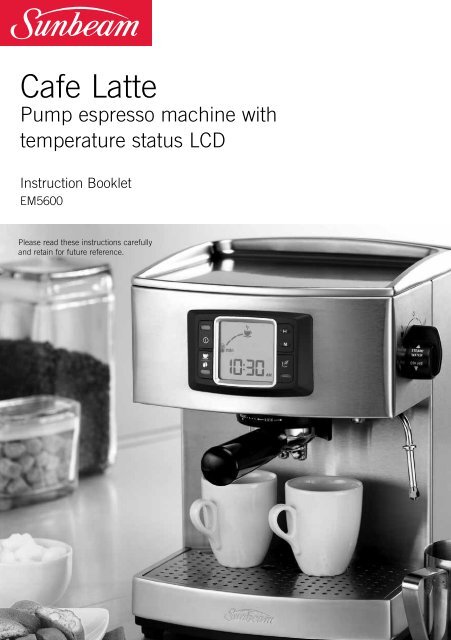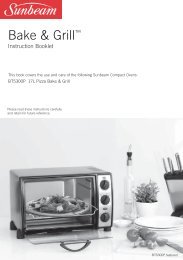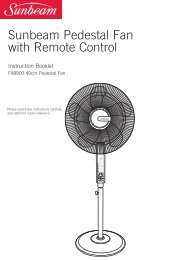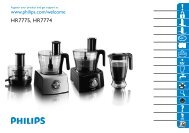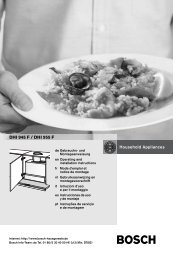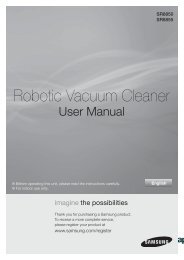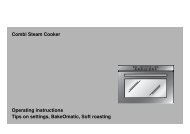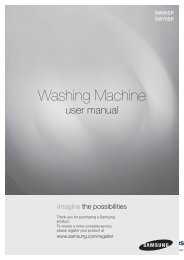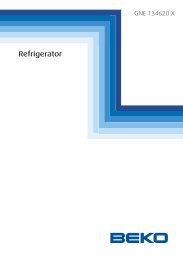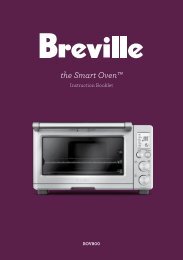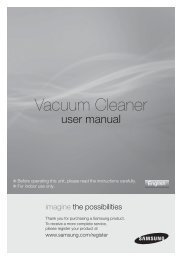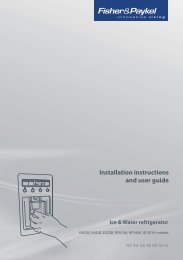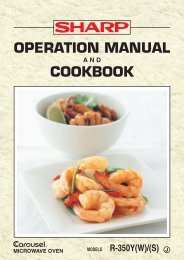You also want an ePaper? Increase the reach of your titles
YUMPU automatically turns print PDFs into web optimized ePapers that Google loves.
<strong>Cafe</strong> <strong>Latte</strong><br />
Pump espresso machine with<br />
temperature status LCD<br />
Instruction Booklet<br />
EM5600<br />
Please read these instructions carefully<br />
and retain for future reference.
2<br />
Sub Heading<br />
Body copy with not indent applied.<br />
• Bullet copy Bullet copy Bullet copy Bullet<br />
copy Bullet copy Bullet copy Bullet copy<br />
Bullet copy
Contents<br />
<strong>Sunbeam</strong>’s Safety Precautions 2<br />
About espresso coffee 3<br />
Features of your <strong>Sunbeam</strong> Café <strong>Latte</strong> 4<br />
Using the control panel<br />
Reference guide to using your espresso<br />
7<br />
machine 9<br />
Preparing your espresso machine before use 14<br />
Guide to the perfect espresso 15<br />
Guide to milk texturing 17<br />
Using the hot water function 18<br />
Espresso recipes 19<br />
Care and cleaning 21<br />
Descaling 23<br />
Trouble shooting guide 25<br />
Important instructions – retain for<br />
future use.
<strong>Sunbeam</strong>’s Safety Precautions<br />
SAFETY PRECAUTIONS FOR YOUR<br />
SUNBEAM ESPRESSO MACHINE.<br />
• Always place the unit on a flat, level surface.<br />
• Do not operate without water in reservoir.<br />
Fill reservoir with only clean and cold water.<br />
Observe maximum filling volume is 2.1 litres.<br />
• Do not remove the filter handle during the<br />
espresso pour or water flow as the unit is<br />
under pressure. Removing the filter handle<br />
during either of these operations can lead to a<br />
scalding or injury.<br />
• The steam wand becomes very hot during<br />
texturing milk and water flow. This may cause<br />
<strong>Sunbeam</strong> is very safety conscious when<br />
designing and manufacturing consumer products,<br />
but it is essential that the product user also<br />
exercise care when using an electrical appliance.<br />
Listed below are precautions which are essential<br />
for the safe use of an electrical appliance:<br />
• Read carefully and save all the instructions<br />
provided with an appliance.<br />
• Always turn the power off at the power outlet<br />
before you insert or remove a plug. Remove<br />
by grasping the plug - do not pull on the cord.<br />
• Turn the power off and remove the plug<br />
when the appliance is not in use and<br />
before cleaning.<br />
• Do not use your appliance with an extension<br />
cord unless this cord has been checked<br />
and tested by a qualified technician or<br />
service person.<br />
• Always use your appliance from a power<br />
outlet of the voltage (A.C. only) marked<br />
on the appliance.<br />
• This appliance is not intended for use by<br />
persons (including children) with reduced<br />
physical, sensory or mental capabilities, or<br />
lack of experience and knowledge, unless they<br />
have been given supervision or instruction<br />
concerning use of the appliance by a person<br />
responsible for their safety.<br />
• Children should be supervised to ensure that<br />
they do not play with the appliance.<br />
• The temperature of accessible surfaces may be<br />
high when the appliance is operating.<br />
• Never leave an appliance unattended while<br />
in use.<br />
2<br />
burns in case of contact, therefore avoid any<br />
direct contact with the steam wand.<br />
• Always disconnect the plug from the power<br />
outlet prior to cleaning the espresso machine<br />
or if there is any problem during the coffee<br />
making process.<br />
• Do not allow the power cord to come into<br />
contact with the hot parts of the espresso<br />
machine, including the cup warming plate and<br />
steam wand.<br />
• Do not place hands directly under the steam,<br />
hot water or coffee pour as this can lead to a<br />
scalding or injury.<br />
• Do not use an appliance for any purpose<br />
other than its intended use.<br />
• Do not place an appliance on or near a hot gas<br />
flame, electric element or on a heated oven.<br />
• Do not place on top of any other appliance.<br />
• Do not let the power cord of an appliance hang<br />
over the edge of a table or bench top or touch<br />
any hot surface.<br />
• Do not operate any electrical appliance with<br />
a damaged cord or after the appliance has<br />
been damaged in any manner. If damage is<br />
suspected, return the appliance to the nearest<br />
<strong>Sunbeam</strong> Appointed Service Centre<br />
for examination, repair or adjustment.<br />
• For additional protection, <strong>Sunbeam</strong><br />
recommend the use of a residual current<br />
device (RCD) with a tripping current not<br />
exceeding 30mA in the electrical circuit<br />
supplying power to your appliances.<br />
• Do not immerse the appliance in water<br />
or any other liquid unless recommended.<br />
• Appliances are not intended to be operated<br />
by means of an external timer or separate<br />
remote control system.<br />
• This appliance is intended to be used in<br />
household and similar applications such<br />
as: staff kitchen areas in shops, offices and<br />
other working environments; farm houses; by<br />
clients in hotels, motels and other residential<br />
type environments; bed and breakfast type<br />
environments.<br />
If you have any concerns regarding the performance and use of your appliance,<br />
please visit www.sunbeam.com.au or contact the <strong>Sunbeam</strong> Consumer Service Line.<br />
Ensure the above safety precautions are understood.
About espresso coffee<br />
Congratulations on the purchase of your<br />
<strong>Sunbeam</strong> Café <strong>Latte</strong> espresso machine.<br />
<strong>Sunbeam</strong>'s experience in designing<br />
appliances for the home has produced a<br />
range of pump espresso machines that are as<br />
beautiful as they are functional.<br />
The <strong>Sunbeam</strong> Café <strong>Latte</strong> makes producing<br />
cafe-quality coffee at home easier than ever<br />
before. As the correct water temperature for<br />
brewing great tasting espresso is between 92<br />
- 94°C, the Café <strong>Latte</strong> has been designed<br />
with a LCD which relays the status of the<br />
water temperature. This indicates the best<br />
time for coffee making or creating steam for<br />
texturing milk.<br />
As our love affair with coffee deepens, our<br />
search for the perfect espresso continues.<br />
A growing favourite for coffee lovers at any<br />
time of the day is the Café Latté, hence the<br />
extra cup height clearance so the espresso<br />
can pour straight into a Latté glass or your<br />
favourite mug.<br />
Drinking authentic café quality coffee at home<br />
is guaranteed with the <strong>Sunbeam</strong> Café <strong>Latte</strong><br />
espresso machine.<br />
The Café <strong>Latte</strong> espresso machine is designed<br />
with quality die-cast metal components and<br />
includes many features that make producing<br />
delicious coffee at home even easier.<br />
We hope you enjoy your new espresso<br />
machine and should you need any further<br />
assistance, please don’t hesitate to contact<br />
the <strong>Sunbeam</strong> Coffee Hotline on free call<br />
1300 881 861 .<br />
3
4<br />
Features of your <strong>Sunbeam</strong> Café <strong>Latte</strong><br />
Warming plate<br />
Effectively pre-warms up to 9 espresso cups.<br />
Control panel with LCD<br />
Easy to use control panel with an LCD<br />
showing the status of the water<br />
temperature.<br />
Group head<br />
Brass and phenolic filter handle<br />
Water level indicator<br />
The water level indicator floats through the<br />
drip tray grid indicating how full the drip tray<br />
is. The top of the indicator has a red band for<br />
easy identification.<br />
Measuring spoon<br />
Tamp
1 cup filter 2 cup filter<br />
2.1L water reservoir<br />
Removable water reservoir for easy filling,<br />
simply lift in any direction.<br />
Operating dial<br />
Easy to operate – turn to the left for espresso/<br />
hot water, or to the right for steam.<br />
Steam wand<br />
Extra cup height clearance<br />
Additional clearance between the filter handle<br />
and the drip tray is designed to suit taller cups.<br />
Removable drip tray and grill<br />
Designed with no dirt traps for small coffee<br />
granules, milk or any other spills. You can<br />
simply wipe clean all surfaces. The drip tray<br />
and grill can be completely removed for easy<br />
cleaning.<br />
Non-slip rubber feet<br />
Makes the unit sturdy, preventing it from<br />
slipping or scratching the benchtop.<br />
500ml jug<br />
5
6<br />
Features of your <strong>Sunbeam</strong><br />
Café <strong>Latte</strong><br />
15 Bar Pump<br />
Italian designed and manufactured, the<br />
machine is fitted with a 15 BAR pump<br />
delivering the pressure required for a<br />
complete extraction of oils, coffee solids and<br />
aroma.<br />
Thermoblock Heating System<br />
The thermoblock heating system heats the<br />
water ensuring the precise temperature is<br />
achieved for each function. Additionally, the<br />
thermoblock is coated with non-stick material<br />
to slow scale build up and reduce the<br />
frequency of cleaning required.<br />
Crema System<br />
Italian designed the cream system consists<br />
of a dual-floor filter creating additional back<br />
pressure and stabilising baffle that helps<br />
retain temperature and produces a steady<br />
pour of espresso.
Using the control panel<br />
Power<br />
Press the ‘POWER’ button once to turn the<br />
espresso machine on. The light located on<br />
the power button will illuminate red and<br />
the temperature indicator line on the LCD<br />
will start to flash from symbol; this is to<br />
indicate that your espresso machine is on<br />
and is heating up.<br />
Note: Before turning on the espresso machine<br />
ensure that the operating dial on the side of<br />
the espresso machine is in the off position.<br />
Depending on the function selected, the<br />
temperature line on the LCD will track<br />
around to either the espresso or steam<br />
temperature setting. When the espresso<br />
machine is heated and ready to use 'READY'<br />
will appear on the LCD.<br />
Note: Remember that if 'READY' is not<br />
displayed on the LCD the espresso machine<br />
is adjusting the temperature of the heating<br />
system.<br />
To turn the espresso machine off, simply<br />
press the power button.<br />
Clock<br />
Note: The clock will automatically begin<br />
keeping time if the correct time is not set.<br />
The correct time does not need to be set to<br />
operate the espresso machine. To set the<br />
clock simply press the 'H' button to select<br />
the hour, ensuring that AM/PM appears<br />
correctly and 'M' button to select the<br />
minutes.<br />
Note: Holding down either the 'H' or 'M'<br />
buttons will allow for rapid time change.<br />
Espresso/Hot water<br />
When the espresso machine is switched on<br />
and the espresso machine is in espresso/hot<br />
water mode, the red light on power button<br />
and the orange light on the button will be<br />
illuminated.<br />
Note: Should the espresso machine not be<br />
in espresso/hot water mode, so the orange<br />
light on button is not on, the coffee<br />
maker needs to press the button to activate<br />
the espresso/hot water mode. By design the<br />
temperature of the espresso machine will<br />
adjust as necessary.<br />
7
8<br />
Using the control panel (continued)<br />
Once the espresso machine is heated to<br />
the correct temperature, the temperature<br />
indicator line will stop flashing and and<br />
'READY' will appear on the LCD, the coffee<br />
maker is then able to use the espresso<br />
machine.<br />
The coffee maker simply needs to turn the<br />
operating dial anticlockwise to the espresso<br />
setting to start the pour and turn it back to<br />
the off position to stop.<br />
Steam<br />
When the espresso machine is switched<br />
on and the espresso machine is in steam<br />
mode, the red light on power button and<br />
the orange light on the steam button will be<br />
illuminated.<br />
Note: Should the espresso machine not<br />
be in steam mode, so the orange light on<br />
the steam button is not on, the coffee<br />
maker needs to press the steam button<br />
to activate the steam mode. By design the<br />
temperature of the espresso machine will<br />
adjust as necessary.<br />
Once the espresso machine is heated to<br />
the correct temperature, the temperature<br />
indicator line will stop flashing and and<br />
'READY' will appear on the LCD, the coffee<br />
maker is able to use the espresso machine.<br />
The coffee maker simply needs to turn the<br />
operating dial clockwise to the steam setting<br />
to start and turn it back to the off position to<br />
stop.
Reference guide to using your<br />
espresso machine<br />
The diagrams below and on the following pages are to assist you in operating your Café <strong>Latte</strong><br />
espresso machine. Each of the diagrams is numbered. Throughout this instruction booklet<br />
reference will be made to these diagrams so each of them has been numbered for convenience<br />
and ease of use.<br />
For example: Fill the water reservoir (1) (2) (3) (4) (5) with cold tap water...<br />
Each time you see these numbers please refer back to the diagrams.<br />
Preparing the espresso machine.<br />
1 2 3<br />
Open lid of water reservoir. Fill in place with cold water.<br />
OR<br />
The espresso machine is<br />
ready to use.<br />
4 5 6<br />
7<br />
8<br />
Remove water reservoir.<br />
Fill at sink with cold water. Replace the water reservoir. Press 'POWER' button to turn<br />
machine on.<br />
2 cup filter<br />
1 cup filter<br />
Warming the espresso cups. Select appropriate filter and<br />
place into handle.<br />
9<br />
9
10<br />
Reference guide to using your espresso machine (continued)<br />
Place filter handle onto<br />
group head.<br />
13<br />
Turn the operating dial to the<br />
espresso setting and allow<br />
water to run through.<br />
Place finely ground coffee<br />
into filter.<br />
10 11 12<br />
16<br />
Turn filter handle to the<br />
right, as far as it will go.<br />
Making the espresso<br />
14<br />
Select appropriate filter and<br />
place into handle.<br />
17<br />
Place large container under<br />
both pouring spouts.<br />
15<br />
Hold filter handle and purge<br />
with water to preheat.<br />
Tamp the coffee grinds. Wipe the edge of filter to<br />
remove any coffee grinds.<br />
18
Reference guide to using your espresso machine (continued)<br />
Place filter handle onto<br />
group head.<br />
Turn the operating dial to<br />
start and stop the espresso<br />
pour.<br />
Texturing milk<br />
19<br />
25<br />
Purge the steam wand by<br />
turning dial to the steam<br />
setting.<br />
Turn filter handle to the<br />
right, as far as it will go.<br />
20 21<br />
Place glasses/cups below<br />
pouring spouts.<br />
22 23 24<br />
Remove filter handle by<br />
turning to the left.<br />
Turn off steam by turning<br />
dial to the off position.<br />
26<br />
Discard the used coffee<br />
grinds.<br />
Swing steam wand to the<br />
side of espresso machine.<br />
27<br />
11
12<br />
Reference guide to using your espresso machine (continued)<br />
28<br />
Place steam wand into milk,<br />
approx. 1cm below surface<br />
and activate the steam<br />
function.<br />
Close the steam by turning<br />
dial to the off position.<br />
Close the hot water by<br />
turning dial to the off<br />
position.<br />
31<br />
Angle jug to rest steam wand<br />
on spout and place nozzle<br />
just below surface of the<br />
milk.<br />
Wipe steam nozzle and wand<br />
with damp cloth and purge a<br />
small amount of steam.<br />
29 30<br />
32 33<br />
34 35 36<br />
Swing the steam/hot water<br />
wand over the drip tray.<br />
Raise the jug until nozzle is<br />
in the centre of milk.<br />
Hot water<br />
Place cup under steam<br />
nozzle and activate the hot<br />
water function by turning dial<br />
to the steam setting.<br />
Cleaning<br />
Remove the drip tray grill.
Reference guide to using your espresso machine (continued)<br />
37 38 39<br />
Remove drip tray. Ensure plastic lining is<br />
clipped back into position in<br />
the drip tray.<br />
Remove water reservoir.<br />
Remove the GREY cleaning<br />
pin from the base of the<br />
espresso machine where<br />
the water reservoir sits.<br />
Remove the BLACK steam<br />
nozzle cleaning pin from the<br />
base of the espresso machine,<br />
where the water reservoir sits.<br />
40 41 42<br />
Insert the cleaning pin into<br />
the single hole in the base of<br />
the filter.<br />
43 44<br />
Insert cleaning pin into the<br />
hole in the base of the steam<br />
wand.<br />
Wrap steam wand with damp<br />
cloth and turn steam on for<br />
10 seconds.<br />
13
14<br />
Preparing your espresso machine<br />
before use<br />
1. Place the espresso machine onto a dry,<br />
stable benchtop.<br />
2. Ensure the drip tray and grill are in place.<br />
3. Fill the espresso machine with water. There<br />
are a couple of ways in which the water<br />
reservoir can be filled;<br />
a) Simply lift the lid of the water reservoir<br />
at the top of the espresso machine (1)<br />
and using a jug, fill with fresh cold<br />
water or filtered water (2).<br />
b) Alternatively the water reservoir can<br />
be removed and filled with fresh cold<br />
water. To do so, lift the lid and using it<br />
as a handle simply slide out the water<br />
reservoir (3). Then fill with fresh cold<br />
water or filtered water (4). Replace the<br />
water reservoir firmly and close the lid<br />
(5).<br />
4. Insert the power cord into a 230-240V<br />
AC power outlet and switch the power on.<br />
Press the power button once to turn the<br />
espresso machine on (6). The light located<br />
on the power button will illuminate red and<br />
the temperature indicator line on the LCD<br />
will start to flash from the symbol, this<br />
is to indicate that your espresso machine is<br />
on and is heating up.<br />
When the temperature indicator line on the<br />
LCD has stopped flashing and 'READY' is<br />
displayed, this indicates that the espresso<br />
machine is heated and ready to use (7).<br />
Note: Before turning on the espresso machine<br />
ensure that the operating dial on the side of<br />
the espresso machine is in the off position.<br />
5. Place glasses and cups on the warming<br />
plate (8).<br />
Important: For first time use or if the machine<br />
has not been used for some time, it is<br />
important that the machine is rinsed as<br />
follows:<br />
6. Fit the filter handle with either the one or<br />
two cup filter basket (9). Secure the filter<br />
handle to the group head (10) (11).<br />
7. Place a sufficiently large container under<br />
both pouring spouts (12).<br />
8. Ensure the espresso machine is in<br />
espresso/hot water mode, so the red light<br />
on the power button and the orange light<br />
on the button are illuminated.<br />
Note: Should the espresso machine not be in<br />
espresso/hot water mode, so the orange light<br />
on the button is not on, the coffee maker<br />
needs to press the button the activate<br />
the espresso/hot water mode. By design the<br />
temperature of the espresso machine will<br />
adjust as necessary.<br />
Once the espresso machine is heated to<br />
the correct temperature, the temperature<br />
indicator line on the LCD will stop flashing<br />
and and 'READY' will be displayed.<br />
Tip: Remember if 'READY' is not displayed on<br />
the LCD the espresso machine is adjusting<br />
the temperature of the heating system.<br />
9. Turn the operating dial anticlockwise to<br />
the espresso setting (13) and allow<br />
the water to run through until the water<br />
reservoir is empty.
Guide to the perfect espresso<br />
Before starting to prepare for making<br />
espresso, ensure the espresso machine is in<br />
espresso/hot water mode, so the red light on<br />
the power button and the orange light on<br />
the button are illuminated.<br />
Note: Should the espresso machine not be in<br />
espresso/hot water mode so the orange light<br />
on the button is not on, the coffee maker<br />
needs to press the button to activate the<br />
espresso/hot water mode.<br />
Preheat Glasses<br />
1. Preheat the glasses/cups by filling them<br />
with hot water as this will assist to preserve<br />
the crema of the espresso. Set the glasses/<br />
cups aside.<br />
Preheat Filter Handle and Filter Basket<br />
2. Select the appropriate filter basket and<br />
place it into filter handle (14).<br />
Tip: Use the one cup filter basket for a single<br />
serve of espresso and the two cup filter<br />
basket for a double serve of espresso.<br />
3. Take the filter handle, hold it under the<br />
group head and purge water. With the filter<br />
basket positioned under the group head<br />
turn the operating dial anticlockwise to the<br />
espresso setting to start the water flow<br />
and turn it back to the off position to stop<br />
(15).<br />
4. Dry the filter basket.<br />
Dosing and Tamping<br />
5. Using the measuring spoon supplied, place<br />
finely ground coffee into the filter basket<br />
(16).<br />
6. Rest the filter handle with the filter basket<br />
in position onto the benchtop. Take the<br />
coffee tamp, apply firm level packing<br />
pressure (17), twisting 90 degrees to<br />
polish the grounds. This seals the surface<br />
of the coffee cake.<br />
7. Brush any excess coffee grounds from<br />
around the edge of the filter basket (18).<br />
Important: Be sure not to over dose the filter<br />
basket with coffee.<br />
Tip: The coffee dosage and the degree of<br />
tamping should remain the same every time<br />
you make a coffee the only thing that should<br />
vary is the coarseness of the coffee grounds<br />
and this will vary depending on the bean. For<br />
example to achieve a slower espresso pour<br />
rate use a finer grind and a coarser grind for<br />
a faster espresso pour rate.<br />
Tip: Ensure the coffee tamp is dry because if<br />
it is wet the coffee grinds will stick to it.<br />
The Espresso Pour<br />
8. Lock the filter handle onto the group head<br />
(19)(20).<br />
9. Empty the glasses/cups and place below<br />
the pouring spouts (21).<br />
Note: Check to see that the espresso machine<br />
is ready for use, remember that if 'READY'<br />
is not displayed on the LCD the espresso<br />
machine is adjusting the temperature of the<br />
heating system.<br />
10. Turn the operating dial anticlockwise to<br />
the espresso setting to start the pour<br />
and turn it back to the off position to<br />
stop (22).<br />
11. Check the espresso pour. The ideal<br />
pour is dark and caramel with reddish<br />
reflections.<br />
12. Serve espresso immediately.<br />
Caring for your Espresso Machine<br />
13. Remove the filter handle from the group<br />
head (23).<br />
14. Discard the used coffee grinds from the<br />
filter basket (24).<br />
15
16<br />
Guide to the perfect espresso (continued)<br />
Tip: After each use of the espresso machine<br />
we recommend that a small amount of water<br />
is cycled through the group head as this will<br />
wash out any old or used coffee grinds stuck<br />
to the underside of the group head. Simply<br />
turn the operating dial to the espresso<br />
setting and allow some water to run through.<br />
Standby Mode<br />
After 1 hour of non-use the espresso machine<br />
will automatically switch to standby mode.<br />
To tell you that the espresso machine is in<br />
standy mode, 'STANDBY' will be displayed on<br />
the LCD and nothing else.<br />
After a further 26 hours of non-use the<br />
espresso machine will turn off.<br />
When the machine is in standby mode by<br />
pressing any button or turning the operating<br />
dial will return the espresso machine to<br />
normal.
Guide to milk texturing<br />
Milk texturing is the steaming of milk. The<br />
steam does two things, firstly it heats the<br />
milk and secondly the steam mixes air<br />
with the milk to form an ‘emulsion’ of tiny<br />
bubbles that gives a silky velvet texture.<br />
Similar to making an espresso, perfecting the<br />
art of milk texturing takes time and practice.<br />
Tip: Remember espresso is the foundation<br />
for all café style drinks and the milk is the<br />
variable.<br />
Before starting to prepare for milk texturing,<br />
ensure the espresso machine is in steam<br />
mode, so the red light on the power button<br />
and orange light on the steam button are<br />
illuninated.<br />
Note: Should the espresso machine not<br />
be in steam mode, so the orange light on<br />
the steam button is not on, the coffee<br />
maker needs to press the steam button to<br />
activate the steam mode.<br />
1. Determine how much milk is needed<br />
based on the number of cups being made<br />
or the size of the texturing jug.<br />
Tip: Keep in mind that the volume of milk<br />
will increase or ’stretch’ during the texturing.<br />
2. Pour cold refrigerated milk into a<br />
stainless steel jug, between ½ to ²/ ³ full.<br />
Tip: Store the stainless steel jug in the fridge<br />
so that it is well chilled. Also be sure not to<br />
rinse the jug with warm water before use.<br />
3. Purge the steam wand of any water.<br />
With the steam wand positioned over the<br />
drip tray activate the steam function by<br />
turning the operating dial to the steam<br />
setting (25). Once any water has been<br />
purged close the steam by turning the<br />
operating dial to the off position (26).<br />
4. Swing the steam wand to the side of the<br />
espresso machine (27).<br />
5. Place the steam wand into the milk so<br />
that the nozzle is about a centimetre<br />
below the surface and activate the steam<br />
function by turning the operating dial to<br />
the setting (28).<br />
6. Angle the jug so that the steam wand is<br />
resting on the spout of the jug and lower<br />
the jug until the tip of the steam nozzle<br />
is just below the surface of the milk. This<br />
will start to create a whirlpool action in<br />
the milk (29).<br />
Note: Do not allow the steam to spurt<br />
unevenly or it will create aerated froth/large<br />
bubbles. If this is happening raise the jug so<br />
that the steam nozzle is lowered deeper into<br />
the milk. Remember the ideal consistency is<br />
a silky velvet texture.<br />
7. As the steam heats and textures the milk,<br />
the level of the milk in the jug will begin<br />
to rise. As this happens follow the level<br />
of the milk by lowering the jug, always<br />
keeping the tip of the steam nozzle just<br />
below the surface.<br />
8. Once the foam is created raise the jug<br />
until the steam nozzle is in the centre of<br />
the milk (30).<br />
Tip: The amount of foam required will vary<br />
depending on the drinks being made, for<br />
example a cappuccino requires more foam<br />
than a flat white.<br />
9. Close the steam immediately when the<br />
milk is heated to between 60-65°C by<br />
turning the operating dial to the off<br />
position (31).<br />
Tip: If you don’t have a thermometer a good<br />
indication that the correct temperature has<br />
been reached is when you are unable to leave<br />
the palm of your hand against the side of the<br />
jug for more than 3 seconds.<br />
Important: Do not boil the milk.<br />
10. Remove the jug, immediately wipe the<br />
steam nozzle and wand with a clean damp<br />
cloth (32) and purge a small amount of<br />
steam.<br />
17
18<br />
Guide to milk texturing (continued)<br />
11. With the jug in hand tap the jug on<br />
the bench top to release the trapped<br />
air bubbles and then swirl the jug in a<br />
circular motion until the milk becomes<br />
shiny and no bubbles remain, this helps<br />
the milk and froth combine for an even<br />
consistency. By swirling the milk you can<br />
see the foam in the jug swirling with your<br />
movement this will enable you to judge<br />
the thickness of your foam.<br />
Using the hot water function<br />
When using the hot water function the<br />
espresso machine needs to be in espresso/hot<br />
water mode, so the red light on the power<br />
button and the orange light on the button<br />
are illuminated.<br />
Note: Should the espresso machine not be in<br />
espresso/hot water mode, so the orange light<br />
on the button is not on, the coffee maker<br />
needs to press the button to activate the<br />
espresso/hot water mode.<br />
The hot water function is ideal for preparing<br />
long blacks, hot chocolate and filling coffee<br />
plungers and tea pots.<br />
1. Place the cup or container under the<br />
steam/hot water nozzle and activate the<br />
hot water function by turning the steam<br />
operating dial to the steam setting (33).<br />
2. Once you have dispensed the required<br />
amount of hot water into the cup or<br />
container, close the hot water by turning<br />
the operating dial to the off position (34).<br />
3. Remove the cup or container and swing the<br />
steam/hot water wand over the drip tray to<br />
catch any drips of water (35).
Espresso Recipes<br />
ESPRESSO (SHORT BLACK)<br />
Espresso is a concentrated, full bodied coffee<br />
with a stable layer of cream on top – known<br />
as ‘crema’. An espresso is the foundation of<br />
all café coffee. Variations are achieved by<br />
adding different amounts of milk and froth.<br />
• 90mL espresso glass or demitasse cup<br />
• single espresso (30-35mL)<br />
LONG BLACK<br />
A standard espresso with hot water, served in<br />
a regular coffee cup or mug. The hot water is<br />
added first so that the ‘crema’ is maintained.<br />
• 190mL cup<br />
• hot water (to taste)<br />
• single or double espresso<br />
MACCHIATO<br />
Macchiato, Italian for ‘to stain or mark’.<br />
Traditionally served as a standard espresso<br />
with a dash of milk and a small dollop of<br />
froth into the middle of the ‘crema’.<br />
• 90mL espresso glass or demitasse cup<br />
• single or double espresso<br />
• marked with steamed milk froth<br />
FLAT WHITE<br />
Another old favourite, the Flat White is<br />
an espresso with steamed milk, served in<br />
a regular coffee cup or mug. The layer of<br />
frothed milk on top should be 2mm to seal<br />
the coffee.<br />
• 190mL cup<br />
• single or double espresso<br />
• steamed milk<br />
19
20<br />
Espresso Recipes (continued)<br />
CAFFE LATTE<br />
An espresso with steamed milk, typically<br />
served in a glass. The layer of frothed milk on<br />
top should be 10mm to seal the coffee.<br />
• 220mL glass or cup<br />
• single or double espresso<br />
• steamed milk<br />
CAPPUCCINO<br />
This delicious drink is an espresso with<br />
steamed milk, topped with creamy froth and<br />
a dusting of chocolate. The resulting drink is<br />
approximately two-thirds milky coffee, onethird<br />
froth.<br />
• 190-240mL cup<br />
• single or double espresso<br />
• two-thirds milky coffee, one-third froth<br />
• dusted with chocolate<br />
CAFFE MOCHA<br />
Made in a similar way to a cappuccino but<br />
with the addition of drinking chocolate.<br />
Simply stir the chocolate into the espresso<br />
prior to adding the steamed milk and froth.<br />
• 190-240mL cup or tall glass<br />
• single or double espresso<br />
• two teaspoons of drinking chocolate<br />
• two-thirds milky coffee, one-third froth<br />
CON PANNA<br />
A variation on the original Vienna coffee, this<br />
delicious drink is made up of an espresso<br />
topped with lightly whipped cream. It can<br />
also be dusted with cinnamon or drinking<br />
chocolate.<br />
• 190mL cup<br />
• single or double espresso<br />
• lightly whipped cream<br />
• dusted with cinnamon or chocolate
Care and Cleaning<br />
The coffee making process involves extracting<br />
oils out of coffee grinds to make espresso<br />
coffee. Deposits of these oils build up over<br />
time and affect the taste of the coffee and<br />
operation of the espresso machine.<br />
Regular cleaning to remove these oils is<br />
essential and will maintain the quality of the<br />
coffee the espresso machine produces and<br />
result in less maintenance being required.<br />
This is easy to do by following a few quick<br />
and easy cleaning steps after each coffee<br />
making session;<br />
Cycle water through the group head,<br />
Purge steam through the steam wand,<br />
Wipe the steam wand clean with a damp<br />
cloth immediately after use,<br />
Remove the filter basket from the filter<br />
handle and clean away any old coffee oils,<br />
and<br />
Empty the drip tray and rinse.<br />
Important: Never wash any of the espresso<br />
machine parts or accessories in the<br />
dishwasher.<br />
Drip tray and grill<br />
Remove the grill and drip tray at regular<br />
intervals to empty (36) (37). Clean with<br />
water and a little non-abrasive washing up<br />
liquid, rinse and dry.<br />
Over time it is normal for the inside of the<br />
drip tray to be stained by the oils in the<br />
coffee.<br />
Note: Ensure that when you are replacing the<br />
drip tray and grill that the plastic lining is in<br />
position (38).<br />
Group head, filter handle & filter baskets<br />
The filter baskets and filter handle should be<br />
rinsed with warm water after each use and<br />
then dried thoroughly.<br />
To clean the group head of any old coffee<br />
grinds cycle water through and wipe the<br />
group head and around the inside rim with a<br />
damp cloth.<br />
Should the holes in the filter baskets become<br />
clogged with coffee granules use a fine<br />
bristled brush to remove them.<br />
Important: Should the filter remain blocked<br />
after normal cleaning, supplied with your<br />
espresso machine is a cleaning pin. The<br />
cleaning pin for the filter is the GREY pin<br />
located under the base of the water reservoir<br />
(39)(40). With the cleaning pin insert it into<br />
the single hole in the base of the filter (41).<br />
Group head rubber seal<br />
The group head seal is located on the<br />
underside of the group head and creates<br />
a seal against the filter handle during the<br />
espresso pour.<br />
Note: During long periods of non-use we<br />
recommend that the filter handle not be<br />
left attached to the group head as this will<br />
reduce the life of the seal.<br />
Over time the seal will lose its elasticity<br />
and require replacement, depending on use<br />
usually every 12 months. Signs that the seal<br />
is deteriorating are when the filter handle<br />
cannot create the necessary seal and steam<br />
escapes from around the group head during<br />
the espresso pour.<br />
Note: Contact <strong>Sunbeam</strong> on 1300 881 861<br />
should you think that the group head seal<br />
needs replacing.<br />
Cup warming plate and exterior<br />
Wipe over the unit with a damp cloth and<br />
wipe dry. Do not use abrasives or metal<br />
scourers as these will scratch the exterior<br />
surface.<br />
21
22<br />
Care and Cleaning (continued)<br />
Steam wand<br />
Keeping the steam arm clean is essential<br />
to ensure maximum efficiency of the steam<br />
function. A build up of caramelised/dried<br />
milk on the steam wand will impair the<br />
steaming and texturing ability of the espresso<br />
machine.<br />
Important: Wipe the steam wand clean with a<br />
damp cloth immediately after each use and<br />
purge a small amount of steam.<br />
Should the milk dry/caramelise on the<br />
steam wand, simply wrap the wand with<br />
a clean damp cloth, turn the steam wand<br />
over the drip tray and turn the steam on for<br />
approximately 10 seconds (42). With the<br />
cloth still on the steam wand leave to soak<br />
for about 5 minutes and you will find that<br />
after this time the dry/caramelised milk will<br />
easily wipe away. Repeat process if still dirty.<br />
Important: Never clean the steam wand with<br />
an abrasive pad as this will damage the<br />
steam wand.<br />
Should the steam wand become blocked,<br />
supplied with the espresso machine is a<br />
cleaning pin. The cleaning pin for the steam<br />
wand is the BLACK pin located under the<br />
base of the water reservoir (39)(43).<br />
With the cleaning pin insert it into the hole<br />
in the base of the steam nozzle (44). Should<br />
the steam wand remain blocked unscrew the<br />
steam nozzle from the steam wand. Clean<br />
the steam nozzle by once again using the<br />
cleaning pin then flush under running water.
Descaling<br />
Scale is a surface build up of minerals that<br />
naturally occur over time in all appliances<br />
that are involved with the heating of water.<br />
Therefore the espresso machine will require<br />
occasional descaling. It is recommended<br />
that the espresso machine is descaled every<br />
4-6 months, this will vary depending on the<br />
frequency of use.<br />
Descaling solution<br />
Use any of the following when descaling the<br />
espresso machine:<br />
<strong>Sunbeam</strong> Espresso Machine Descaling<br />
Tablets<br />
<strong>Sunbeam</strong> Liquid Descaler, or<br />
Vinegar Solution.<br />
Descaling the espresso machine<br />
Note: Ensure the espresso machine is turned<br />
off and the power cord is unplugged.<br />
1. Remove the water reservoir and rinse clean.<br />
Depending on the descaling solution being<br />
used use one of the following:<br />
A. <strong>Sunbeam</strong> Espresso Machine Descaling<br />
Tablets<br />
Fill the water reservoir with 1 litre of warm<br />
water and place a descaling tablet into the<br />
reservoir. Once the tablet has dissolved<br />
replace the reservoir, this takes about 5-7<br />
minutes.<br />
B. <strong>Sunbeam</strong> Liquid Descaler<br />
Fill the water reservoir with approximately<br />
1.5 litres of water, add 1 capful of<br />
<strong>Sunbeam</strong> Liquid Descaler and replace the<br />
reservoir.<br />
C. Vinegar solution<br />
Fill the water reservoir with approximately<br />
1.5 litres of warm water, add 3 tablespoons<br />
of vinegar and replace the reservoir.<br />
2. Should the filter handle be attached to<br />
the group head remove it, rinse thoroughly<br />
under running water and set aside.<br />
3. Using a screwdriver unscrew the brewing<br />
filter/shower screen from the underside of<br />
the group head.<br />
4. Remove and set aside the filter/screen,<br />
washer and screw in a safe place.<br />
Important: Be careful not to lose the filter/<br />
screen, washer and screw once you have<br />
disassembled the group head.<br />
5. Using a small brush scrub in and around<br />
the area at the brewing head, removing all<br />
coffee granules.<br />
6. Place a sufficiently large container under<br />
the group head.<br />
7. Insert the power cord into a 230-240V AC<br />
power outlet and switch the power ‘ON’.<br />
Press the power button once to turn the<br />
espresso machine on.<br />
Note: Remember if 'READY' is not displayed<br />
on the LCD the espresso machine is adjusting<br />
the temperature of the heating system.<br />
Once the espresso machine is heated to<br />
the correct temperature, the temperature<br />
indicator line on the LCD will stop flashing<br />
and and 'READY' will be displayed, this<br />
indicates that the espresso machine is heated<br />
and ready to use.<br />
8. Turn the operating dial anticlockwise to the<br />
espresso setting and allow half the<br />
solution to cycle through the group head.<br />
Important: Do not run descaling solution<br />
through the steam wand.<br />
Note: Depending on the size of the container<br />
under the group head on occasion this may<br />
need to be emptied throughout this process.<br />
9. After half the solution has cycled through<br />
turn the operating dial to the off position<br />
to stop the flow and then press the<br />
power button to turn the machine off.<br />
23
24<br />
Descaling (continued)<br />
10. Leave the machine off for 10-15 minutes<br />
to allow the descaler solution to take<br />
affect.<br />
11. Press the power button once to turn<br />
the espresso machine on.<br />
12. Turn the operating dial to the espresso<br />
setting and allow the remaining solution<br />
to cycle through the group head.<br />
13. Remove the water reservoir from the<br />
machine and rinse thoroughly under<br />
running water, ensuring that all traces<br />
of the descaling solution is removed.<br />
Fill with clean water and replace the<br />
reservoir.<br />
14. Turn the operating dial to the espresso<br />
setting and allow the entire water<br />
reservoir to cycle through the group head.<br />
Note: Depending on the size of the container<br />
under the group head on occasion this may<br />
need to be emptied throughout this process.<br />
15. When this is finished remove the<br />
container under the group head and give<br />
the machine a good wipe over.<br />
16. Carefully replace the rubber seal, brewing<br />
filter/shower screen and washer to the<br />
group head. Tighten well.<br />
17. Fill the water reservoir with fresh water<br />
and position it on to the machine.
Trouble Shooting guide<br />
PROBLEM POSSIBLE CAUSE WHAT TO DO<br />
Coffee runs down the side of Filter handle is not attached correctly, Ensure the handle is firmly positioned<br />
the filter handle. or has not been tigtened sufficiently. onto the group head. See “Guide to<br />
the perfect espresso” pg 15.<br />
Edge of filter insert is not free Clean around the top edge of the<br />
of coffee granules. filter and wipe the group head clean<br />
of coffee.<br />
The group head is dirty. Wipe group head with a<br />
damp cloth.<br />
The group head is defective. Contact a <strong>Sunbeam</strong> Service Centre.<br />
Group head rubber seal is damaged, Contact a <strong>Sunbeam</strong> Service Centre.<br />
or warn.<br />
No coffee runs through. No water in the water reservoir. Fill reservoir with water.<br />
Water reservoir not correctly Press firmly down on the water reservoir<br />
assembled. to ensure it is correctly positioned.<br />
Operating dial set to Ensure the operating dial is in the<br />
setting. off position.<br />
Group filter may be blocked. See “Descaling” pg 23.<br />
The filter is blocked, the coffee Empty out the filter and rinse under<br />
grounds are too fine or tamped water to clean. Wipe the group head<br />
down too hard. with a cloth. Repack the filter and tamp<br />
down coffee lightly with compactor.<br />
Coffee pours out in drops. Coffee grind is too fine or are Ensure you are using an evenly ground<br />
too compacted. coffee and do not compact the grounds<br />
so firmly.<br />
Machine blocked by scale build up. See “Descaling” pg 23.<br />
Espresso does not have any Coffee is old or dry. Use fresh coffee and once you open the<br />
Crema. coffee be sure to store it in an airtight<br />
container.<br />
Coffee not compacted firmly enough. Compact coffee grounds more<br />
firmly.<br />
Coffee too coarse. Grind the coffee to a finer texture or<br />
change brands of espresso coffee to a<br />
finer grind.<br />
25
26<br />
Trouble Shooting guide (continued)<br />
Espresso does not have any Not enough coffee in filter. See "Guide to the perfect espresso"<br />
Crema. pg 15.<br />
Handle comes off during group. Coffee tamped too hard. Tamp the coffee grounds lighter.<br />
Coffee grind is too fine. Change to a coarser grind of coffee.<br />
Filter handle is not attached correctly, Ensure the handle is firmly positioned<br />
or has not been tightened sufficiently. onto the group head.<br />
See "Guide to the perfect espresso"<br />
pg 15.<br />
Top edge of filter is not free of coffee Clean around the edge of the filter and<br />
granules. wipe the group head clean of coffee.<br />
The group head is dirty. Wipe group head with a damp cloth.<br />
The group head is defective. Contact a <strong>Sunbeam</strong> Service Centre.<br />
Group head rubber seal is warn or Contact a <strong>Sunbeam</strong> Service Centre.<br />
damaged.<br />
Coffee is too cold. Cups, filter and filter hand are cold. Pre-heat cups, filters, handle and<br />
filter. See "Guide to the perfect<br />
espresso" pg 15.<br />
If making a cappuccino or latte Ensure that milk is heated properly<br />
the milk may not be heated enough. during texturing, but be sure not to boil<br />
the milk. See "Guide to milk texturing"<br />
pg 17.<br />
No steam from the steam nozzle. Steam nozzle is blocked. See "Care & Cleaning" pg 21.<br />
Not enough froth when frothing Milk is not fresh. Ensure the milk is fresh.<br />
Milk temperature is too warm. Ensure that the milk is well refrigerated<br />
before use.<br />
Jug. For best texturing results use a stainless<br />
steel jug and if possible refrigerate or<br />
run the jug under cold water before use.<br />
Steam nozzle is blocked. See "Care & Cleaning" pg 21.<br />
Milk has been boiled. Start again with fresh, chilled milk.<br />
Uneven cup filling. Uneven tamping or obsruction in the Ensure coffee is tamped evenly<br />
pouring spouts. and check that there is nothing<br />
obstructing the pouring spouts.
Trouble Shooting guide (continued)<br />
Uneven cup filling. Defective baffle in filter handle. Contact a <strong>Sunbeam</strong> Service Centre.<br />
Espresso tastes burnt. Type of coffee being used. Experiment with different brands of<br />
coffee.<br />
Appliance has not been rinsed Run a reservoir full of water properly<br />
after descaling. through the machine before making<br />
another coffee.<br />
Pump makes an unusually No water in reservoir. Fill the water reservoir.<br />
load noise.<br />
Water reservoir not correctly Replace the water reservoir<br />
positioned. firmly into the unit.<br />
Machine does not operate. Group head filter may be blocked. Remove filter holder and clean group<br />
head. See "Care & Cleaning" pg 21.<br />
Machine blocked by scale See “Descaling ” pg23.<br />
build up.<br />
Please contact <strong>Sunbeam</strong> directly on Freecall 1300 881 861, if this guide does not solve your<br />
query. We have experienced staff on hand to assist, Monday to Friday.<br />
27
Notes
12 Month Replacement Guarantee<br />
In the unlikely event that this appliance develops any malfunction<br />
within 12 months of purchase (3 months commercial use) due to<br />
faulty materials or manufacture, we will replace it for you<br />
free of charge.<br />
Should you experience any difficulties with<br />
your appliance, please phone our customer<br />
service line for advice on 1300 881 861 in<br />
Australia, or 0800 786 232 in New Zealand.<br />
Alternatively, you can send a written claim<br />
to <strong>Sunbeam</strong> at the address listed below.<br />
On receipt of your claim, <strong>Sunbeam</strong> will<br />
seek to resolve your difficulties or, if the<br />
appliance is defective, advise you on how<br />
to obtain a replacement or refund.<br />
Your <strong>Sunbeam</strong> 12 Month Replacement<br />
Guarantee naturally does not cover misuse<br />
or negligent handling and normal wear and<br />
tear.<br />
Similarly your 12 Month Replacement<br />
Guarantee does not cover freight or any other<br />
costs incurred in making a claim. Please<br />
retain your receipt as proof of purchase.<br />
The benefits given to you by this guarantee<br />
are in addition to your other rights and<br />
remedies under any laws which relate to the<br />
appliance.<br />
Our goods come with guarantees that cannot<br />
be excluded under the Australian Consumer<br />
Law and under the New Zealand Consumer<br />
Guarantees Act.<br />
In Australia you are entitled to a<br />
replacement or refund for a major failure and<br />
for compensation for any other reasonably<br />
foreseeable loss or damage. You are also<br />
entitled to have the goods repaired or<br />
replaced if the goods fail to be of acceptable<br />
quality and the failure does not amount to<br />
a major failure.<br />
Should your appliance require repair or<br />
service after the guarantee period, contact<br />
your nearest <strong>Sunbeam</strong> service centre.<br />
For a complete list of <strong>Sunbeam</strong>’s authorised<br />
service centres visit our website or call:<br />
Australia<br />
www.sunbeam.com.au<br />
1300 881 861<br />
Units 5 & 6, 13 Lord Street<br />
Botany NSW 2019 Australia<br />
New Zealand<br />
www.sunbeam.co.nz<br />
0800 786 232<br />
26 Vestey Drive, Mt Wellington<br />
Auckland, New Zealand
Need help with your appliance?<br />
Contact our customer service team or visit<br />
our website for information and tips on<br />
getting the most from your appliance.<br />
In Australia<br />
Visit www.sunbeam.com.au<br />
Or call 1300 881 861<br />
In New Zealand<br />
Visit www.sunbeam.co.nz<br />
Or call 0800 786 232<br />
is a registered trademark.<br />
‘<strong>Cafe</strong> <strong>Latte</strong>’ is a trademark of <strong>Sunbeam</strong> Corporation.<br />
Made in China.<br />
Due to minor changes in design or otherwise,<br />
the product may differ from the one shown in this leaflet.<br />
© Copyright. <strong>Sunbeam</strong> Corporation Limited 2010.<br />
ABN 45 000 006 771<br />
Units 5 & 6, 13 Lord Street<br />
Botany NSW 2019 Australia<br />
Unit 3, Building D<br />
26 Vestey Drive<br />
Mt Wellington Auckland<br />
New Zealand<br />
<strong>Sunbeam</strong> Corporation is a division of GUD Holdings Ltd. 8/11


